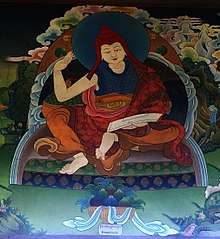Kamalaśīla
Kamalaśīla (Skt. Kamalaśīla; Tib. པདྨའི་ངང་ཚུལ་, Pemé Ngang Tsul; Wyl. pad+ma'i ngang tshul)[1] (c. 740-795) was an Indian Buddhist of Nalanda Mahavihara who accompanied Śāntarakṣita (725–788)[2] to Tibet at the request of Trisong Detsen.

| Part of a series on |
| Tibetan Buddhism |
|---|
 |
|
|
|
Practices and attainment |
|
Institutional roles |
|
History and overview |
Lineage
Dargyay, et al. (1977, 1998: p. 7) convey a lineage of transmission and translation of Śīla, Sutrayana Buddhavacana and the Six Pāramitā (viewed principally through the Mahayana teachings of Nagarjuna), from India to Tibet (pandit in this context denotes a Sanskrit scholar):
The Indian pandits, represented mainly by Śāntarakṣita, Kamalaśīla, and his disciple Ye-śes-dbang-po, form a known group. These scholars were all defenders of the Madhyamaka school, which is based upon Nāgārjuna's teachings. First of all, however, they taught the ten rules of behaviour of the Buddhist ethics (śīla) and a summary of the teachings according to the canonic Sūtras of the Mahāyāna, as well as the virtuous works of the six pāramitās. These exercises are supposed to lead, in a long seemingly endless way, to the gradual ascent to the acquisition of higher intellectual abilities finally culminating in Buddhahood. This trend was intensified after the debate of bSam-yas had taken place in the years 792 to 794; the exact outcome of this debate is still debatable.[3]
Debate of Samye
In 793 Trisong Detsen resolved that Moheyan did not hold the true dharma. Following intense protests from Moheyan's supporters, Trisong Detsen proposed to settle the matter by sponsoring a debate, the "Council of Lhasa", although it may actually have taken place at Samye, a considerable distance from Lhasa. Kamalaśila was invited to represent Vajrayana while Moheyan represented the East Mountain Teaching of Chan Buddhism. Most Tibetan sources state that the debate was decided in Kamalaśīla's favour (though many Chinese sources claim Moheyan won)[4] and Moheyan was required to leave the country and that all sudden-enlightenment texts were gathered and destroyed by royal decree. This was a pivotal event in the history of Tibetan Buddhism, which would afterward continue to follow the late Indian model with only minor influence from China.[5] Moheyan's teachings were a mixture of the East Mountain Teachings[note 1] associated with Yuquan Shenxiu and with the teachings of Baotang Wuzhu.[6]
The Cham dance
There is a Cham dance that retells the story of the Council of Lhasa related to the teachings of Chöd. Moheyan is generally depicted as of ample girth, goaded by children.[7] Chöd is a product of both the Indian and Chinese transmissions of Buddhism into the Himalayas. For a discussion of the Dunhuang fulcrum of the entwined relationship of Chinese and Indian Buddhism see van Schaik and Dalton (2004).[8]
For simplicity, the Vajrayana transmission may be characterised as "gradual" (Wylie: rim gyis 'jug pa ; Chinese: dunwu) and the Chan as "direct" (Wylie: cig car gyi 'jug pa ; Chinese: jianwu).[9] It needs to be emphasised that this neat dichotomy in characterisation of these two approaches is only valid for the historical context of the great debate between Kamalaśīla and Moheyan and even then it is still open to dialectic.
According to the lore of the orthodox, prevailing Tibetan cultural tradition, Kamalaśīla, a scholar educated at Nalanda, advocated the "gradual" process to enlightenment; whereas, Moheyan, as a trance and meditation master, advocated the "direct" awakening of original mind through the nirodha of discursive thought, the cessation of the mind of ideation. The historicity of this debate has been drawn into question by Tucci & Heissig (1970),[10] Gomez (1983)[11] and Ruegg (1992)[12] though this does not lessen its importance in defining the religious and cultural traditions of Tibet.[13] Kamalaśīla was very handsome and a great orator and historically "won" the debate: though there are conflicting primary sources and secondary accounts.
One hagiography asserts that directly after this debate with Moheyan, as Kamalaśīla was making his way down from the Himalaya to the Indian lowlands, he was incited to enact phowa through compassionate duress, transferring his mindstream to animate a corpse polluted with a dangerous infection and thereby safely moving the hazard it presented to a nearby community. As the mindstream of Kamalaśīla was otherwise engaged, a mahasiddha by the name of Dampa Sangye came across the vacant body of Kamalaśīla. Padampa Sangye was not karmically blessed with an aesthetic corporeal form, and upon finding the very handsome and healthy empty body of Kamalaśīla, which he perceived as a newly-dead fresh corpse, transferred his mindstream into Kamalaśīla's body. Padampa Sangye's mindstream in Kamalaśīla's body continued the ascent to the Himalaya and thereby transmitted the Chöd.
The mindstream of Kamalaśīla, upon endeavouring to return to his body, was unable to do so and resorted by necessity to the vacant body of Padampa Sangye.[14] The mindstream of Padampa Sangye continued in this body, and it is in this handsome body that the transmission of Chöd was made to Machig Labdrön, his consort.[15]
Works
Trilogy of Stages of Meditation (bhāvanākrama)
Kamalaśīla is renowned for writing three texts, all called Bhāvanākrama (Stages of Meditation), which summarize and build upon aspects of the Yogacara tradition of Asanga, particularly as pertaining to aspects of meditation practice and mental cultivation (bhavana).[16] The first volume was translated into Classic Chinese.[17]
Commentary on Madhyamālaṃkāra
(Sanskrit: Madhyamālaṃkāra-panjika, Wylie: dbu ma rgyan gyi dka' 'grel)
Commentary on Difficult Points (Sanskrit: Madhyamālaṃkāra-panjika, Wylie: dbu ma rgyan gyi dka' 'grel) by Kamalaśīla
See also
Bibliography
- Kamalaśīla; Kiyotaka Goshima (1983). The Tibetan Text of the Second Bhāvanākrama. Goshima Kiyotaka.
- Kamalaśīla (1997). Bhāvanākramaḥ: Tibetan version, Sanskrit restoration and Hindi translation. Central Inst. of Higher Tibetan studies.
- Kamalaśīla (1997). Bhāvanākrama of Kamalaśila: Transl. Into English by Parmananda Sharma. Aditya Prakashan. ISBN 978-81-86471-15-9.
- Kamalaśīla (1998). The Stages of Meditation: Bhāvanākrama II. Middle volume. Translated by Geshe Lhundup Sopa; Elvin W. Jones; John Newman. Deer Park Books.
- Shūki Yoshimura (1953). Tibetan Buddhistology: Introductory notes: Bhāvanākrama. Research Society for the Eastern Sacred Books, Ryukoku University.
- Kamalaśīla (2007). Kamalashila: The Stages of Meditation, Bhavanakrama II (online text). Dharma Teachings Project.
Notes
- Chinese: 東山法門 tung-shan fa-men; given the appellation of "Northern School" Chan by Shenhui (670–762)
References
- Shedra, Rigpa. "Kamalashila". Rigpa Wiki. Retrieved 15 December 2017.
- Blumenthal, James (2008). "Śāntarakṣita", The Stanford Encyclopedia of Philosophy (Winter 2008 Edition), Edward N. Zalta (ed.). Source: (accessed: 28 February 2009).
- Dargyay, Eva M. (author) & Wayman, Alex (editor) (1977, 1998). The Rise of Esoteric Buddhism in Tibet. Second revised edition, reprint. Delhi, India: Motilal Banarsidass Publishers Pvt Ltd. Buddhist Tradition Series Vol. 32. ISBN 81-208-1579-3 (paper), p.7
- Powers 2004, pp. 38–44
- Yamaguchi 1997.
- Hanson-Barber 1985.
- An iconographic thangka depiction of Moheyan is held in the SAMA collection and may be seen here "Archived copy". Archived from the original on 20 July 2008. Retrieved 8 June 2009.CS1 maint: archived copy as title (link) (accessed: 14 January 2008)
- van Schaik, Sam and Dalton, Jacob (2004). "Where Chan and Tantra Meet: Buddhist Syncretism in Dunhuang" in Whitfield, Susan (ed) (2004). The Silk Road: Trade, Travel, War and Faith. London: British Library Press. 61–71.
- van Schaik, Sam (2007). The Great Perfection and the Chinese Monk: rNyingmapa defences of Hwashang Mahāyāna in the Eighteenth Century. Source: Archived 29 August 2007 at the Wayback Machine (accessed: 14 January 2007)
- Dargyay, Eva M. (author) & Wayman, Alex (editor) (1977, 1998). The Rise of Esoteric Buddhism in Tibet. Second revised edition, reprint. Delhi, India: Motilal Banarsidass Publishers Pvt Ltd. Buddhist Tradition Series Vol. 32. ISBN 81-208-1579-3 (paper), p.74, note 21.
- Gomez, Luis O. (1983). "The Direct and Gradual Approaches of Zen Master Mahāyāna: Fragments of the Teachings of Moheyan" in: Gimello, Robert M. and Peter N. Gregory (eds), Studies in Chan and Hua-yen. Honolulu: University of Hawaii Press: 393–434.
- Ruegg, D. Seyfort (1992). Buddha-nature, Mind and the Problem of Gradualism in a Comparative Perspective: On the Transmission and Reception of Buddhism in India and Tibet. London: School of Oriental and African Studies.
- van Schaik, Sam (2007). The Great Perfection and the Chinese Monk: rNyingmapa defences of Hwashang Mahāyāna in the Eighteenth Century. Source: Archived 29 August 2007 at the Wayback Machine (accessed: 14 January 2007)
- Thrangu, Khenchen & Klonk, Christoph (translator) & Hollmann, Gaby (editor and annotator) (2006). Chod – The Introduction & A Few Practices (accessed: 28 September 2008)
- Source: Archived 30 January 2016 at the Wayback Machine (Thursday, 5 November 2007)
- Adam, Martin T. (2003). Meditation and the concept of insight in Kamalaśīla's Bhāvanākramas, Montreal: McGill Univ., Dissertation (includes translations)
- 廣釋菩提心論 Archived 8 September 2012 at the Wayback Machine
Sources
- Hanson-Barber, A. W. (1985), "'No-Thought' in Pao-T'ang Ch'an and Early Ati-Yoga", Journal of the International Association of Buddhist Studies, 8 (2): 61–73
- Tucci, G. and Heissig, W. (1970). Die Religionen Tibets und der Mongolei. Stuttgart.
- Yamaguchi, Zuihō (1997), The Core Elements of Indian Buddhism Introduced into Tibet'. In: Jamie Hubbard and Paul L. Swanson (ed.), Pruning the Bodhi Tree: The Storm over Critical Buddhism, Honolulu: University of Hawai'i Press, ISBN 978-0-8248-1949-1
External links
- The Tattvasangraha (with commentary) English translation by Ganganatha Jha, 1937 (includes glossary)